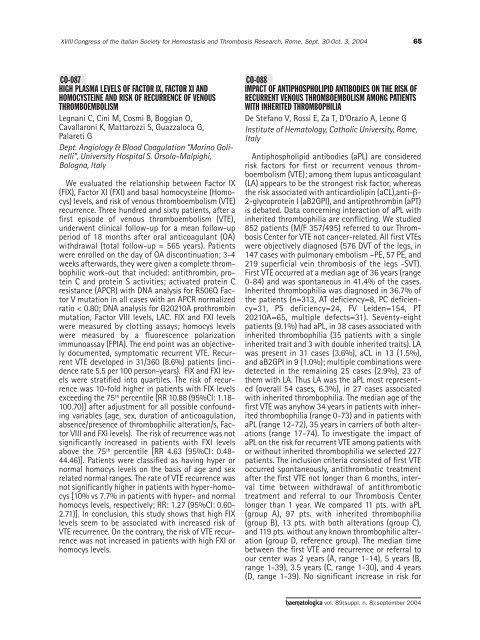Haematologica 2004;89: supplement no. 8 - Supplements ...
Haematologica 2004;89: supplement no. 8 - Supplements ...
Haematologica 2004;89: supplement no. 8 - Supplements ...
- No tags were found...
Create successful ePaper yourself
Turn your PDF publications into a flip-book with our unique Google optimized e-Paper software.
XVIII Congress of the Italian Society for Hemostasis and Thrombosis Research, Rome, Sept. 30-Oct. 3, <strong>2004</strong>65CO-087HIGH PLASMA LEVELS OF FACTOR IX, FACTOR XI ANDHOMOCYSTEINE AND RISK OF RECURRENCE OF VENOUSTHROMBOEMBOLISMLegnani C, Cini M, Cosmi B, Boggian O,Cavallaroni K, Mattarozzi S, Guazzaloca G,Palareti GDept. Angiology & Blood Coagulation “Mari<strong>no</strong> Golinelli”,University Hospital S. Orsola-Malpighi,Bologna, ItalyWe evaluated the relationship between Factor IX(FIX), Factor XI (FXI) and basal homocysteine (Homocys)levels, and risk of ve<strong>no</strong>us thromboembolism (VTE)recurrence. Three hundred and sixty patients, after afirst episode of ve<strong>no</strong>us thromboembolism (VTE),underwent clinical follow-up for a mean follow-upperiod of 18 months after oral anticoagulant (OA)withdrawal (total follow-up = 565 years). Patientswere enrolled on the day of OA discontinuation; 3-4weeks afterwards, they were given a complete thrombophilicwork-out that included: antithrombin, proteinC and protein S activities; activated protein Cresistance (APCR) with DNA analysis for R506Q FactorV mutation in all cases with an APCR <strong>no</strong>rmalizedratio < 0.80; DNA analysis for G20210A prothrombinmutation, Factor VIII levels, LAC. FIX and FXI levelswere measured by clotting assays; homocys levelswere measured by a fluorescence polarizationimmu<strong>no</strong>assay (FPIA). The end point was an objectivelydocumented, symptomatic recurrent VTE. RecurrentVTE developed in 31/360 (8.6%) patients (incidencerate 5.5 per 100 person-years). FIX and FXI levelswere stratified into quartiles. The risk of recurrencewas 10-fold higher in patients with FIX levelsexceeding the 75 th percentile [RR 10.88 (95%CI: 1.18-100.70)] after adjustment for all possible confoundingvariables (age, sex, duration of anticoagulation,absence/presence of thrombophilic alteration/s, FactorVIII and FXI levels). The risk of recurrence was <strong>no</strong>tsignificantly increased in patients with FXI levelsabove the 75 th percentile [RR 4.63 (95%CI: 0.48-44.46)]. Patients were classified as having hyper or<strong>no</strong>rmal homocys levels on the basis of age and sexrelated <strong>no</strong>rmal ranges. The rate of VTE recurrence was<strong>no</strong>t significantly higher in patients with hyper-homocys[10% vs 7.7% in patients with hyper- and <strong>no</strong>rmalhomocys levels, respectively; RR: 1.27 (95%CI: 0.60-2.71)]. In conclusion, this study shows that high FIXlevels seem to be associated with increased risk ofVTE recurrence. On the contrary, the risk of VTE recurrencewas <strong>no</strong>t increased in patients with high FXI orhomocys levels.CO-088IMPACT OF ANTIPHOSPHOLIPID ANTIBODIES ON THE RISK OFRECURRENT VENOUS THROMBOEMBOLISM AMONG PATIENTSWITH INHERITED THROMBOPHILIADe Stefa<strong>no</strong> V, Rossi E, Za T, D'Orazio A, Leone GInstitute of Hematology, Catholic University, Rome,ItalyAntiphospholipid antibodies (aPL) are consideredrisk factors for first or recurrent ve<strong>no</strong>us thromboembolism(VTE); among them lupus anticoagulant(LA) appears to be the strongest risk factor, whereasthe risk associated with anticardiolipin (aCL),anti-β-2-glycoprotein I (aB2GPI), and antiprothrombin (aPT)is debated. Data concerning interaction of aPL withinherited thrombophilia are conflicting. We studied852 patients (M/F 357/495) referred to our ThrombosisCenter for VTE <strong>no</strong>t cancer-related. All first VTEswere objectively diag<strong>no</strong>sed (576 DVT of the legs, in147 cases with pulmonary embolism –PE, 57 PE, and219 superficial vein thrombosis of the legs -SVT).First VTE occurred at a median age of 36 years (range0-84) and was spontaneous in 41.4% of the cases.Inherited thrombophilia was diag<strong>no</strong>sed in 36.7% ofthe patients (n=313, AT deficiency=8, PC deficiency=31,PS deficiency=24, FV Leiden=154, PT20210A=65, multiple defects=31). Seventy-eightpatients (9.1%) had aPL, in 38 cases associated withinherited thrombophilia (35 patients with a singleinherited trait and 3 with double inherited traits). LAwas present in 31 cases (3.6%), aCL in 13 (1.5%),and aB2GPI in 9 (1.0%); multiple combinations weredetected in the remaining 25 cases (2.9%), 23 ofthem with LA. Thus LA was the aPL most represented(overall 54 cases, 6.3%), in 27 cases associatedwith inherited thrombophilia. The median age of thefirst VTE was anyhow 34 years in patients with inheritedthrombophilia (range 0-73) and in patients withaPL (range 12-72), 35 years in carriers of both alterations(range 17-74). To investigate the impact ofaPL on the risk for recurrent VTE among patients withor without inherited thrombophilia we selected 227patients. The inclusion criteria consisted of first VTEoccurred spontaneously, antithrombotic treatmentafter the first VTE <strong>no</strong>t longer than 6 months, intervaltime between withdrawal of antithrombotictreatment and referral to our Thrombosis Centerlonger than 1 year. We compared 11 pts. with aPL(group A), 97 pts. with inherited thrombophilia(group B), 13 pts. with both alterations (group C),and 119 pts. without any k<strong>no</strong>wn thrombophilic alteration(group D, reference group). The median timebetween the first VTE and recurrence or referral toour center was 2 years (A, range 1-14), 5 years (B,range 1-39), 3.5 years (C, range 1-30), and 4 years(D, range 1-39). No significant increase in risk forhaematologica vol. <strong>89</strong>(suppl. n. 8):september <strong>2004</strong>
















